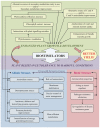Biostimulators: A New Trend towards Solving an Old Problem
- PMID: 27303430
- PMCID: PMC4885868
- DOI: 10.3389/fpls.2016.00748
Biostimulators: A New Trend towards Solving an Old Problem
Abstract
Stresses provoked by adverse living conditions are inherent to a changing environment (climate change and anthropogenic influence) and they are basic factors that limit plant development and yields. Agriculture always struggled with this problem. The survey of non-toxic, natural, active substances useful in protection, and stimulation of plants growing under suboptimal and even harmful conditions, as well as searching for the most effective methods for their application, will direct our activities toward sustainable development and harmony with nature. It seems highly probable that boosting natural plant defense strategies by applying biostimulators will help to solve an old problem of poor yield in plant cultivation, by provoking their better growth and development even under suboptimal environmental conditions. This work is a concise review of such substances and methods of their application to plants.
Keywords: bioregulators; biostimulants; environmental stresses; organic farming; plant stress physiology.
Figures
References
-
- Abbas S. M., Akladious S. A. (2013). Application of carrot root extract induced salinity tolerance in cowpea (Vigna sinensis L.) seedlings. Pak. J. Bot. 45 795–806.
-
- Abdalla M. M. (2013). The potential of Moringa oleifera extract as a biostimulant in enhancing the growth, biochemical and hormonal contents in rocket (Eruca vesicaria subsp. sativa) plants. Int. J. Plant Physiol. Biochem. 5 42–49.
-
- Bulgari R., Cocetta G., Trivellini A., Vernieri P., Ferrante A. (2015). Biostimulants and crop responses: a revive. Biol. Agric. Hortic. 31 1–17. 10.1080/01448765.2014.964649 - DOI
-
- Cambri D. (2008). “Amino acids: the scientific basis of the biostymulation,” in Book of Abstracts – Biostimulators in Modern Agriculture, Arysta Life Science Poland, Warsaw: 14.
Publication types
LinkOut - more resources
Full Text Sources
Other Literature Sources


